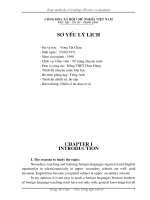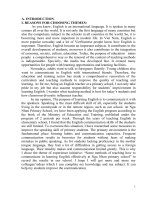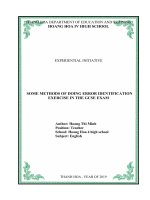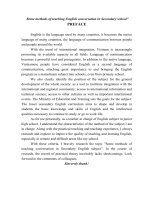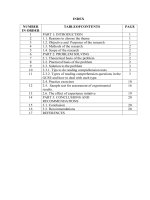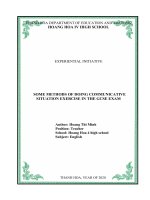skkn cấp tỉnh some methods of doing reading comprehension exercises in the gcse exam
Bạn đang xem bản rút gọn của tài liệu. Xem và tải ngay bản đầy đủ của tài liệu tại đây (222.49 KB, 23 trang )
<span class="text_page_counter">Trang 1</span><div class="page_container" data-page="1">
THANH HOA DEPARTMENT OF EDUCATION AND TRAINING
<b>HOANG HOA IV HIGH SCHOOL</b>
EXPERIENTIAL INITIATIVE
<b>SOME METHODS OF DOING</b>
<b> READING COMPREHENSION EXERCISES IN THE GCSE EXAM</b>
<b>Author: Hoang Thi MinhJob position: Teacher</b>
<b>School: Hoang Hoa 4 high schoolSubject: English</b>
THANH HOA, YEAR OF 2024
</div><span class="text_page_counter">Trang 2</span><div class="page_container" data-page="2"><b> INDEX</b>
1. INTRODUCTION1.1. Rationale
1.2. Aims of the study1.3. Objects of the study1.4. Methods of the study
11112. CONTENTS OF THE STUDY
2.1.Theoretical background2.2. Practical background
2.3.Implimentation and sollution
2.4. Results after applying the reasearch in teaching
122183. CONCLUSION AND SUGGESTION
Reference materialIndex
19
</div><span class="text_page_counter">Trang 3</span><div class="page_container" data-page="3"><b>1. INTRODUCTION:</b>
<b>1.1. RATIONALE (Reasons for choosing the topic):</b>
There is no doubt that learning English is very important. Especially, since theschool year 2013-2014, it is compulsory for high school students throughoutVietnam to do English test in the GCSE exam and the Entrance UniversityExam (also called the National Examination for high school students). Thisheightens the need for teachers to investigate alternative approaches to teachingskills that would lead to significant improvement in students’ marks.
Reading is one of exercises in the GCSE exam which most students havedifficulties in.
There are some reasons for this. Firstly, most students are lack of vocabulary ofspecific topic to read a passage, so they are afraid of reading. Secondly, nearlyall of teachers mainly focus on teaching the theory of grammar, they don’t teachstudents the methods of doing this exercise. When correcting for the students,the teachers often help their students to find the key and not explain how to findthe answer. It is for such reasons that my experiential initiative attempts toexplore
<i><b>“ Some methods of doing reading comprehension exercises in the GCSEexam ”</b></i>
<b>1.2. AIMS OF THE STUDY: </b>
My school is in the country, most of my students come from poorfamilies. They learn English without the support of advanced technology suchas: computers, laptops. They don’t have a lot of chances to learn English atEnglish centers. The students’ learning English mainly depends on their teachersand textbooks. I myself take responsibility for the job and create several simplyways to improve the score of the students in the GCSE exam.
<b>1.3. OBJECTS OF THE STUDY:</b>
The objects chosen for this study are 12<small>th</small>- form students at Hoang Hoa 4high school, Thanh Hoa province where I have been teaching for 17 years.
<b>1.4. METHODS OF THE STUDY: </b>
To achieve the objectives of the study, several methods are used, but I usemainly quantitative and qualitative methods.
The data serving the research analysis and discussions are collected by meansof a survey questionnaire for students and observation.
<b>2. THE CONTENTS OF THE EXPERIENCE INITIATIVES 2.1. THEORETICAL BACKGROUND:</b>
English as a language has great reach and influence; it is taught all over theworld. English may not be the most spoken language in the world, but it is theofficial language in a large number of countries. English is the language ofscience, of aviation, computers, diplomacy, and tourism. Knowing Englishincreases students’ chances of getting a good job in a multinational companywithin their home country or of finding work abroad.
Knowing the methods of doing multiple choice questions, especially themethods of doing reading comprehension exercises will help the students gainhigh score in the GCSE exam.
</div><span class="text_page_counter">Trang 4</span><div class="page_container" data-page="4">Such practical background has led me to my experiential initiative:
<i><b>“Some methods of doing reading comprehension exercises in the GCSE</b></i>
<i><b>exam”. </b></i>
<b>3. IMPLEMENTATION AND SOLUTIONS:</b>
<b>3.1. TYPES OF READING COMPREHENSION EXERCIES IN THEGCSE EXAM</b>
<b>There are three reading comprehension exercises in the GCSE exam</b>
<i><b>divided into two forms : The first one is reading and indicating the correct</b></i>
<i><b>option that best fits each of the numbered blanks. The second one is readingand indicating the correct answer to each of the questions</b></i>
<i><b>3.2. TYPES OF QUESTIONS IN EACH FORM</b></i>
<i><b>The first form - reading and indicating the correct option that best fits each ofnumbered blanks- has five questions</b></i>
<i>Question 1: related to choosing relative pronouns such as “who”, “which”,“that” …</i>
<i>Question 2: related to quantity such as “many”, “much”, “little” ….</i>
<i>Question 3: related to linking words and phrases such as “so”, “and”,“however”, “ therefore” ….</i>
<i>Question 4 : related to fixed phrases such as “fond of”, “ make a decision” ,“pay a visit”, “contribute to” ……</i>
<i>Question 5: related to vocabulary </i>
<i><b>The second form - reading and indicating the correct answer to each of thequestions - has some types of question</b></i>
<i>Questions related to vocabulary ( Vocabulary questions)</i>
<i>Questions related to content of the text ( Details in paragraph questions)Questions about main idea of the text ( Main idea questions)</i>
<i>Question of reference questions ( Reference questions)Questions of inference ( Inference questions)</i>
</div><span class="text_page_counter">Trang 5</span><div class="page_container" data-page="5"><i><b>3.3. HOW TO DO EACH TYPES OF QUESTIONS IN EACH FORM</b></i>
<i><b>The first form - reading and indicating the correct option that best fits each ofnumbered blanks</b></i>
<i><b>Question 1 : related to relative pronouns such as “ who”, “ which”, “ that” …</b></i>
To do this question, teachers ask students to remember the function of relativepronouns ( to replace noun mentioned in the first sentence) so students have toidentify the noun before relative pronouns.
<i>- If the noun before relative pronoun is a person such as “ a teacher”, “ theman”, “ father” …. we choose relative pronouns “ who” , “whom” or “that”.Who + Verb, Whom + S + V .“ That” is not used after commas (,) orpreposition ( on, in , at …)</i>
<i>Ex:<b><small>Read the following passage and mark the letter A, B, C, or D to indicate the correctword or phrase that best fits each the numbered blanks.</small></b></i>
<i> Even though ICTs play significant roles in representing equalization strategy</i>
for developing countries, the reality of the digital divide, which is the gapbetween those people having access to, and control technology and those people(40) _______ do not make a huge difference in the use of ICTs
<b>Question 40. A. whoseB. whichC. whoD. whenThe answer for question 40 is C “ who ” - replace those people </b>
<i>- If the noun before relative pronoun is a thing such as “ a table”, “ thecompany”, “ the event ” we choose relative pronoun “ which” or “that” . “That” is not used after commas (,) or preposition ( on, in , at …)</i>
<i><b>Ex: Read the following passage and mark the letter A, B, C, or D to indicate</b></i>
<i><b>the correct word or phrase that best fits each the numbered blanks.</b></i>
Besides, there were only a few distinctive professional careers like doctor,
<b>engineer, accountant, nurse, teacher,etc. to think about. Most higher learning</b>
usually led to a financially successful life. Besides, the cost of education was notso high. Today’s world is entirely different from the things (29) ______ havejust been described
<b>Question 29. A. whoseB. thatC. whoD. whenThe answer for question 29 is “that ” - replace the things</b>
<i>- If the noun before relative pronoun is a place such as “ the environment”, “the house”, “ the street” ….. we choose relative pronoun “ where” </i>
<i>Ex: <b><small>Read the following passage and mark the letter A, B, C, or D to indicate the correctword or phrase that best fits each the numbered blanks.</small></b></i>
<b>Dung to transport the money between Feb. 26 and Sep. 12, 2022, to the</b>
company on Tran Hung Dao Street and Sherwood Building on Pasteur Street(28)_______ she lived, both in HCMC’s District 1
<b>Question 28. A. whoseB. whichC. whoD. where</b>
</div><span class="text_page_counter">Trang 6</span><div class="page_container" data-page="6"><b>The answer for question 28 is “where” - replace a place: Tran Hung Dao Street</b>
and Sherwood Building on Pasteur Street
<i><b>Note: other relative pronouns such as “ whose”, “when”, “why” hardlyappear in this question .</b></i>
<i><b>Question 2 : related to quantity such as “many”, “much”, “little” ….</b></i>
To do this question, teachers asks students to identify the noun after thequantity.
<i>- If the noun after the quantity is a plural noun, we choose quantity like“many”, “ a lot of”, “a few”, “some”, “other”, “all”, “most” ….</i>
<i><b>Ex: Read the following passage and mark the letter A, B, C, or D to indicate</b></i>
<i><b>the correct word or phrase that best fits each the numbered blanks.</b></i>
… ICTs are making dynamic changes in society as well as influencing (39)_______ aspects of life. …..
<b>Question 39. A. everyB. eachC. allD. much The answer is “ all” because “ aspects” is plural noun </b>
<i>- If the noun after the quantity is a singular countable noun, we choose quantitylike “a”, “ one”, “each”, “every”, “another ”, ….</i>
<i><b>Ex: Read the following passage and mark the letter A, B, C, or D to indicate</b></i>
<i><b>the correct word or phrase that best fits each the numbered blanks.</b></i>
Problem-solving, which is identifying problems and selecting potentialsolutions, is (23)_________ essential component.
<b>Question 23. A. another B. otherC. the otherD. othersThe answer is “ another ” because “ component” is singular countable noun </b>
<i>- If the noun after the quantity is a singular uncountable noun, we choosequantity like “little”, “a little”, “much ”, “a lot of ”, “a mount of” ….</i>
<i>Note: “ a little” has negative meaning </i>
<i><b>Ex: Read the following passage and mark the letter A, B, C, or D to indicate</b></i>
<i><b>the correct word or phrase that best fits each the numbered blanks.</b></i>
Truong My Lan has denied she ordered her driver to deliver a(n) (26)_______VND 108 trillion ($4.38 billion) and $14.7 million in cash from SaigonCommercial Bank to her company and home.
<b>Question 26: A. number of B. lots of C. plenty of D. amount of</b>
<b>The answer is “ amount of ” because “ VND 108 trillion” is singular</b>
</div><span class="text_page_counter">Trang 7</span><div class="page_container" data-page="7"><i><b>Ex: Read the following passage and mark the letter A, B, C, or D to indicate</b></i>
<i><b>the correct word or phrase that best fits each the numbered blanks.</b></i>
In the old days, it was not much a problem to do the task because there were notso many diverse learning areas to choose from. (28)______, there were only afew distinctive professional careers like doctor, engineer, accountant, nurse,
<b>teacher,etc. to think about. </b>
<b>Question 28: A. In addition B. So C. Because D. ThereforeThe answer is “ In addition” because it adds idea or information</b>
<i>- If it shows contrast we choose linking words or phrases like : “ however”,“but”, “although”, “in spite of/ despite” , “ by contrast” ….</i>
<i><b>Ex: Read the following passage and mark the letter A, B, C, or D to indicate</b></i>
<i><b>the correct word or phrase that best fits each the numbered blanks.</b></i>
She told the People’s Court of Ho Chi Minh City Monday that (29) ______ themoney was indeed taken to those locations, it was not on her orders. SherwoodBuilding is not home but an office, she said.
<b>Question 29: A. When B. If C. Although D. SoThe answer is “ Although” because it shows contrast</b>
<i>- If it gives reason we choose linking words or phrases like : “ because”,“because of”, “as”, “since” , ….</i>
<i><b>Ex: Read the following passage and mark the letter A, B, C, or D to indicate</b></i>
<i><b>the correct word or phrase that best fits each the numbered blanks.</b></i>
The floor can have other uses too; one of them is to record how many
<b>people visit a shopping centre. This kind of information is very useful for shopowners (29) _______,very often they want to know at which times of days they</b>
have the highest numbers of customers. So the next time you visit a bigshopping centre, have a careful look at the floor that you are walking across!
<b>Question 29: A. because of B. because C. although D. SoThe answer is “ ” because” it gives the reason</b>
<i>- If it shows results we choose linking words or phrases like : “ so”, “therefore”, “as a result ”, “as a consequence” , …</i>
<i><b>Ex: Read the following passage and mark the letter A, B, C, or D to indicate</b></i>
<i><b>the correct word or phrase that best fits each the numbered blanks.</b></i>
…. Failure to handle the challenges would mean a further widening of theknowledge gap and deepening of existing economic and social inequalitiesamong the developed and the developing countries. (42) _______, the purposeof this review article is to discuss the benefits of ICT use in education, in theenhancement of student learning and experiences of some countries
<b>Question 42. A. On the contrary B. HoweverC. ThereforeD. BesidesThe answer is “ Therefore” because it shows result</b>
<i><b>Question 4 : related to fixed phrases such as “fond of”, “ make a decision” ,“pay a visit”, “contribute to” ……</b></i>
</div><span class="text_page_counter">Trang 8</span><div class="page_container" data-page="8"><i>To do this question, teachers ask students to take a sight words or phrases afteror before to identify the fixed phrases.</i>
<i><b>Ex. Read the following passage and mark the letter A, B, C, or D to indicate</b></i>
<i><b>the correct word or phrase that best fits each the numbered blanks.</b></i>
Failure to (41) _______ the challenges would mean a further widening of theknowledge gap and deepening of existing economic and social inequalitiesamong the developed and the developing countries.
<b>Question 41. A. handleB. controlC. takeD. make The answer is “handle” because we can see after it is “the challenges”. Wehave a fixed phrase “handle the challenges”</b>
<i><b>Ex2: Read the following passage and mark the letter A, B, C, or D to indicate</b></i>
<i><b>the correct word or phrase that best fits each the numbered blanks<small>.</small></b></i>
As teenagers approach university level, a decision has to be made on whatcourse to pursue. In this world of diversity, (26) ______ such a choice is noteasy for both children and parents
<b>Question 26: A. taking B. making C. giving D. having The answer is “making” because we can see after it is “a choice”. We have afixed phrase “make a choice”</b>
<i><b>Question 5: related to vocabulary </b></i>
<i>To do this question, teachers ask students to read and understand. To clearlyunderstand this vocabulary students should read one or two sentences aroundthe word to understand the context and meaning of the word by applyingscanning technique. After understanding the meaning and context of thevocabulary, students an immediately eliminate inappropriate words and choosethe most suitable answer.</i>
<i><b>Ex1: Read the following passage and mark the letter A, B, C, or D to indicate</b></i>
<i><b>the correct word or phrase that best fits each the numbered blanks.</b></i>
Meanwhile, most teenagers have difficulty in identifying their own(30)_______. There are a variety of well- organized career talks and studentcounseling workshop to guide and help teenagers decide what course to take.
<b>Furthermore, psychological tests are also used. </b>
<b>Question 30: A. disgrace B.encouragement C. interests D. carelessness</b>
<i><b>The answer is “interests: sở thích ” because students can base on the meaningof “most teenagers” , “difficulty” , “ identifying” , “counseling workshop” , “</b></i>
<i><b>guide”, “help”, “decide what course to take”</b></i>
<i><b>Ex2. Read the following passage and mark the letter A, B, C, or D to indicate</b></i>
<i><b>the correct word or phrase that best fits each the numbered blanks.</b></i>
<b>Conclusion, developments in IT have brought many (28) ______, yet I believe</b>
developments relating to new technology in the future are likely to producemany negative effects that will need to be addressed very carefully.
<b>Question 28: A. money B. benefits C. challenges D. increases</b>
<i><b>The answer is “benefits” because students can base on the meaning of“brought” , “yet”, “ negative effects” </b></i>
</div><span class="text_page_counter">Trang 9</span><div class="page_container" data-page="9"><i><b>The second form - reading and indicating the correct answer to each of thequestions - has some types of question</b></i>
<b>The steps to do reading exercises: </b>
<small></small> Step 1: Skim the passage to grasp the basic information of the passage
<small></small> Step 2: Read the answers. Students should look at the answers to thequestions. Then, determine what type of questions are ( grammar orword choice)
<small></small> Step 3: Read the passage carefully: you should carefully read thesentence containing the question and adjacent sentences (before andafter) to find answer information. No need to read to understand all theinformation. Please read carefully section containing informationrelated to the question.
<small></small> Step 4 : Read the entire passage: If you have used all the steps abovebut still cannot find the answer. Students need to read the wholepassage carefully to find the necessary information.
<small></small> Step 5: Choose: For the easy questions, you can immediately see theanswer at a glance. You can reply immediately without having to gothrough the steps above. After that, it is necessary to look at all theanswers. Because the question usually has one approximate answer andone correct answer. Most students often lose points on these questions,so you must be careful with any type of test.
<i>Questions related to vocabulary ( Vocabulary questions)</i>
<b>Questions that often appears:</b>
<i>- The expression “ABC” in line/ paragraph “1,2,3” could be replaced by ….- The word “ABC” in line/ paragraph “ 1,2,3” is the CLOSEST /OPPOSITEmeaning to ….</i>
<i><b>To do this question teachers ask students follow three steps</b></i>
<i>+ Step 1. Locate: Normally words / phrases will be bolded in the reading sostudents can easily identify them.</i>
<i>+ Step 2. Read and understand: To clearly understand this vocabulary studentsshould read one or two sentences around the word to understand the contextand meaning of the word by applying scanning technique</i>
<i>+ Step 3. Eliminate: After understanding the meaning and context of thevocabulary, students an immediately eliminate inappropriate words and choosethe most suitable answer.</i>
<i><b>Ex1: Read the following passage and mark the letter A, B, C, or D on your</b></i>
<i><b>answer sheet to indicate the correct answer to each of the questions </b></i>
…... Machines already perform a lot of tasks that were usually done by humans,such as building cars, doing complex calculations, and even marking exampapers. But now it seems that ever more intelligent machines are straying into
<b>areas where we never envisaged they would go. We have always taken pride in</b>
having a unique kind of intelligence that machines could never match, onewhich allows us to think of new ideas and produce creative and artisticworks…….
</div><span class="text_page_counter">Trang 10</span><div class="page_container" data-page="10"><b>Question 37: The word “envisaged” in paragraph 1 could be replaced</b>
by ...…
<b>A. prepared B. encouragedC. imagined D. experienced </b>
<small></small> Step 1 - Vocabulary in the second sentence 2 paragraph 2
<small></small> Step 2: Apply scanning for reading comprehension
+ Machines - perform - tasks that were done by humans. But now it - moreintelligent - straying into areas - we never envisaged they would go. We - pridein having - intelligence that machines - never match, one - allows us - think -new ideas - produce creative and artistic works.
=> Máy móc đã thực hiện nhiều nhiệm vụ mà con người thường làm. Nhưng giờđây, (nó - những cỗ mày này) đã thông minh hơn và đang lấn vào những lĩnhvực mà chúng ta chưa bao giờ envisaged chúng sẽ đến. Chúng ta ln tự hào sởhữu một loại trí thơng minh mà máy móc khơng bao giờ có thể sánh kịp, mộtloại trí tuệ cho phép chúng ta nghĩ ra những ý tưởng mới và tạo ra những tácphẩm sáng tạo và nghệ thuật.
<small></small> Step 3: After combining the answer into context, students will see thatanswer C is the most suitable
<b>A. prepared (v): chuẩn bị</b>
<b>B. encouraged (v): khuyến khíchC. imagined (v): tưởng tượng</b>
<b>D. experienced (v): có kinh nghiệm</b>
=> Nhưng giờ đây, (nó - những cỗ mày này) đã thơng minh hơn và đang lấn vàonhững lĩnh vực mà chúng ta chưa bao giờ tưởng tượng chúng sẽ đến.
=> envisaged = imagined
<i><b>Ex2. Read the following passage and mark the letter A, B, C, or D on your</b></i>
<i><b>answer sheet to indicate the correct answer to each of the questions </b></i>
Machines can easily be trained to do the physical work of producing art. Aboutten years ago, a painting robot known as e-David was created at a university inGermany. And recently in New York, the painting 'Portrait of Edmond deBelamy' has been auctioned for nearly half a million dollars. What made it a
<b>bit unusual was that the idea, and the image itself, was produced entirely by a</b>
computer. A group of young French artists gave instructions to the computer,aiming simply to show that computers can be creative.
<b>Question 39: The word “unusual” in paragraph 2 is CLOSEST in meaning</b>
to ...…
<b>A. strange B. complicated C. simple D. uneasy</b>
<small></small> Step 1 - Vocabulary in line 4 paragraph 2
<small></small> Step 2: Apply scanning for reading comprehension
Machines - be trained - do - work of producing art. Ten years ago, a paintingrobot - e-David was created at a university in Germany. Recently in NewYork, the painting 'Portrait of Edmond de Belamy' - auctioned for nearly halfa million dollars. What made it a bit unusual was that the idea, - the image -was produced entirely by a computer.
=> Máy móc có thể được đào tạo để thực hiện cơng việc sản xuất nghệ thuật.Khoảng mười năm trước, một robot vẽ tranh tên là e-David đã được tạo ra tại
</div><span class="text_page_counter">Trang 11</span><div class="page_container" data-page="11">một trường đại học ở Đức. Và mới đây tại New York, bức tranh 'Portrait ofEdmond de Belamy' đã được bán đấu giá gần nửa triệu đô la. Điều khiến nó hơi“unusual” là ý tưởng và hình ảnh được tạo ra hồn tồn bằng máy tính.
<small></small> Step 3: After combining the answer into context, students will see thatanswer A is the most suitable
<b>A. strange (adj): lạ, bất thường</b>
B. complicated (adj): phức tạpC. simple (adj): đơn giản
D. uneasy (adj): không dễ dàng
=> Điều khiến nó hơi bất thường là ý tưởng và bản thân hình ảnh được tạo rahồn tồn bằng máy tính.
=> unusual = strange (adj): lạ, bất thường
<i>Questions related to content of the text ( Details in paragraph questions)</i>
<b>Questions that often appears:</b>
- According to the passage…- It is stated in the passage…- The passage indicates that…
- Which of the following is TRUE/NOT TRUE…?
<i>To do this question teachers ask students follow three steps+ Step 1. Read the question and identify keyword </i>
<i>+ Step 2. Underline information in which line or which paragraph</i>
<i>+ Step 3 . Eliminate information not mentioned or not true compared to the text</i>
<i><b>Ex1. Read the following passage and mark the letter A, B, C, or D on your</b></i>
<i><b>answer sheet to indicate the correct answer to each of the questions </b></i>
Machines can easily be trained to do the physical work of producing art. Aboutten years ago, a painting robot known as e-David was created at a university inGermany. And recently in New York, the painting 'Portrait of Edmond deBelamy' has been auctioned for nearly half a million dollars. What made it abit unusual was that the idea, and the image itself, was produced entirely by acomputer. A group of young French artists gave instructions to the computer,aiming simply to show that computers can be creative.
Question 38: According to paragraph 2, the painting 'Portrait of Edmond deBelamy' ...
<b>A. was created by a computer</b>
B. was painted ten years ago
C. was painted by some French artistsD. was created by e-David
<i>+ Step 1. Keyword: “Portrait of Edmond de Belamy”+ Step 2. Information in the sentence 2,3 paragraph 2 </i>
<i>+ Step 3 . Eliminate information not mentioned or not true compared to the text</i>
So the correct answer is A. Evidence sentence 2,3 paragraph 2 “ What made it abit unusual was that the idea, and the image itself, was produced entirely by acomputer”
</div>
